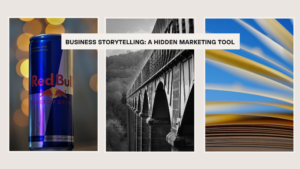Margaret Atwood said: “You’re never going to kill storytelling, because its built into the human plan. We come with it”.
We come with storytelling built in because the words of a true story are realised only by the emotions they talk to. Story telling is written into the anatomy of our DNA. Not necessarily the skill to write the story, but the ability to resonate with a story.
Storytelling
Storytelling is not a written medium. It is not a visual medium, or even an aural medium. Yes, a story can be told; visually with pictures, videos, reels and TikToks; on pages and online by words inscribed on a page or screen; it can even be heard from word of mouth. Storytelling is an emotional art form – a way of sharing and communicating emotions which conjure feelings in our fellow humans. It is expression.
You may ask, if we use that parameter of definition whether all expression is a story? Our answer to that is simply, yes. There is a desire within all of us to share our story and that is what we spend our days doing, creating a life, and a story which defines us. Everyday we seek to share our emotions through the stories we tell in conversation, in social media caption or image, in paint or picture, in the babble of a child. Communication is storytelling in its rawest format, and it is the nature of us all to share our story.
Sharing stories
Carl Jung, an American philosopher from the mid 1900’s suggests that there is a “collective unconscious” within society. A psychological register of human experiences comprised of shared symbols and imageries; storytelling taps into this universal. His theory is widely supported, many believing it to have merit. Perhaps thinking of this idea in connection with social media, the universality of human experience may be highlighted.
Taking a viral Instagram reel for example. What makes it so successful? The content? Or is it the way in which the content taps into human experience in a way which many people can relate to? Next time you hit the like button or comment on an Instagram or Facebook reel, see if you can decipher why you chose to hit that button. Odds on it will be because you get the content on an emotional level.
Social connections
Dr Pamela Rutledge explains the power of storytelling in great depth, including exploring the primary function of a story as a form of social connection. A core tenet of what she says about the power of storytelling is that:
“Stories talk in images, engaging our right brain and triggering our imagination, allowing us to ‘see’ new worlds and new ways of being. Through the imagination, we become participants in a story. We can step into someone else’s shoes, see differently, and increase our empathy for others.”
Engaging the imagination in another is the hidden key to unlocking the power of storytelling. The imagination is the key to the social connection that renders a story successful or not. Imagination is as unique and intangible as the feel of the wind on another person’s skin, but it is the secret sauce in the art of storytelling.
Imagination
The power of the imagination in the art of storytelling is somewhat of a mystery, even among literary and psychological scholars. It is an unknowable component that is completely recognisable to every human being on a primal level. When listening, watching, or talking, if the imagination fails to engage, we lose interest.
That interest is often hard to capture again. Think about the culture of ‘doom scrolling’. A modern problem all storytellers face as people’s imaginations, overwhelmed by constant story content now gives only a split-second to an image or caption before whizzing by. Stories, long, short, visual, and written flood social media every day, but unless it is imagination capturing to many it will fall flat.
Capturing Imagination
Fortunately, the imagination is not a collective power but rather an individual one. Each person’s response is going to be unique. That is why storytelling needs to be focused. Telling a story in a captivating way which appeals to the imagination, has a structure, and retains the imaginative attention to the end is another hidden and mysterious component of the art.
The imagination is arguably one of the most illusive and easily lost processes for most people. A good storyteller keeps the imagination, inspiring, and captivating readers to follow the story through to the end. The alluring promise of information seductively withheld and developed by the storyteller.
Who is a storyteller
We are all storytellers. The birth and prevalence of social media stands as testament to that. Writing short captions about our experiences and thoughts, publishing images and reels to share experiences. The people who become professional storytellers usually have an interest in communication through a medium that fascinates and perplexes. Of course, others just learn the patterns of the craft, repeating structures to achieve connections.
Connections achieved by a true storyteller will leave you half-in, half-out of the journey you have been on. Realism suspended; you will never feel the presence of a storyteller in any medium. What they capture is not themselves, but the emotion of the audience before them. A good storyteller will leave a lasting resonance in your mind, of characters, of events, of experiences. A resonance that touches the imagination enough to spark an emotional response. In that response, the consumer of the story is motivated.
Stories motivate
Motivation is the outcome of every good story through any medium. Whether you are motivated to comment, share, or like. Whether you are motivated to buy a t-shirt, read another novel by the same author, hug the person in front of you; a good storyteller makes the people act.
Consuming stories and responding is essentially how we communicate. Stories are what make us human, and a good storyteller understands how to appeal to emotions. Emotions motivate us to act, and the power of the story is in the conviction it delivers that makes you act.
Conviction
Every story must be told with conviction to be authentic and believable for the consumer. Without a consistent voice telling the narrative and clear objectives, stories lose their way. The narrative drifts, the video is too long, the focus shifts erratically. The consumer of the story loses focus and becomes disinterested in the meandering.
Wobbly videos, misspelt words, and poorly constructed lines cause disengagement. These things tell us, as consumers of a story, that the creator has no conviction and no faith in their own construction. This in turn leads consumers to abandon stories part way through, just as the storyteller has done. Although stories that grip readers never seem to follow a structure, embedded in the twists and turns of emotional resonance, a structure lurks.
Structure
A beginning, a middle, and an end. It’s the basic formula for a storyteller. Although good storytellers will sometimes trick you into thinking you have joined in the middle or at the end. All stories must follow this premise.
Introduce your topic, discuss it, and conclude it in a way which makes the consumer always want more from the story you have created. It’s a very simple formula, that is actually complex. Taking practice, knowledge, and skill, all storytellers have to learn the craft of the medium they communicate in.
The art of storytelling is never static; it’s dynamic. New mediums rise with social needs and fall with popularity, but the art of storytelling itself never dies. Embracing change and experimenting is part of the storytelling process; only through experimentation can you understand how to best communicate a story.
Experimentation
Some may call it drafting, others may call it garbage. Stories develop and good story tellers know that storytelling involves process. Capturing the unique voice needed to resonate with the emotions of the person you are speaking to rarely happens off the cuff. The process needs experimentation.
Social media and digital content allows for this and provides the perfect platform to hone the audience for your story. Blogs can be written to engage with different audiences and provide a variety of stories on numerous topics all under one umbrella heading. Facebook groups, Instagram comments, TikToks, all provide insights into what works as a storytelling medium as people experiment with different forms of expression.
The art of storytelling is the art of being the ghost in the medium. Of being the invisible guide gently shifting the story consumer on a journey through imagination, emotional engagement, and wonder.
Conclusion
Stories come in many forms, but the art of telling that story is the same no matter what your medium. You must capture the imagination. Be bold and truthful, and speak to the emotions of others with integrity and authenticity if you want your story to resonate and cause reaction. That is the hidden art of storytelling. But shhhh, don’t tell anyone I told you.




